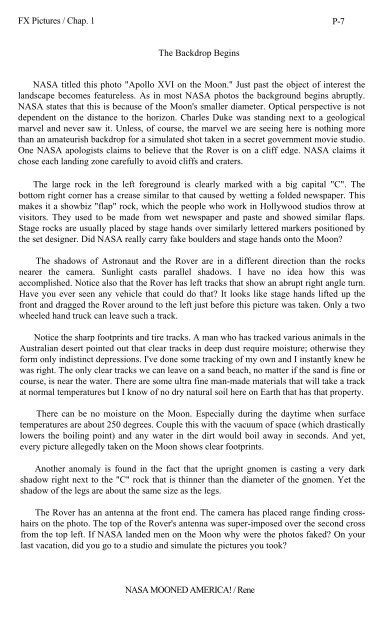Rene-NASA-Mooned-America
Rene-NASA-Mooned-America
Rene-NASA-Mooned-America
Create successful ePaper yourself
Turn your PDF publications into a flip-book with our unique Google optimized e-Paper software.
FX Pictures / Chap. 1 P-7<br />
The Backdrop Begins<br />
<strong>NASA</strong> titled this photo "Apollo XVI on the Moon." Just past the object of interest the<br />
landscape becomes featureless. As in most <strong>NASA</strong> photos the background begins abruptly.<br />
<strong>NASA</strong> states that this is because of the Moon's smaller diameter. Optical perspective is not<br />
dependent on the distance to the horizon. Charles Duke was standing next to a geological<br />
marvel and never saw it. Unless, of course, the marvel we are seeing here is nothing more<br />
than an amateurish backdrop for a simulated shot taken in a secret government movie studio.<br />
One <strong>NASA</strong> apologists claims to believe that the Rover is on a cliff edge. <strong>NASA</strong> claims it<br />
chose each landing zone carefully to avoid cliffs and craters.<br />
The large rock in the left foreground is clearly marked with a big capital "C". The<br />
bottom right corner has a crease similar to that caused by wetting a folded newspaper. This<br />
makes it a showbiz "flap" rock, which the people who work in Hollywood studios throw at<br />
visitors. They used to be made from wet newspaper and paste and showed similar flaps.<br />
Stage rocks are usually placed by stage hands over similarly lettered markers positioned by<br />
the set designer. Did <strong>NASA</strong> really carry fake boulders and stage hands onto the Moon<br />
The shadows of Astronaut and the Rover are in a different direction than the rocks<br />
nearer the camera. Sunlight casts parallel shadows. I have no idea how this was<br />
accomplished. Notice also that the Rover has left tracks that show an abrupt right angle turn.<br />
Have you ever seen any vehicle that could do that It looks like stage hands lifted up the<br />
front and dragged the Rover around to the left just before this picture was taken. Only a two<br />
wheeled hand truck can leave such a track.<br />
Notice the sharp footprints and tire tracks. A man who has tracked various animals in the<br />
Australian desert pointed out that clear tracks in deep dust require moisture; otherwise they<br />
form only indistinct depressions. I've done some tracking of my own and I instantly knew he<br />
was right. The only clear tracks we can leave on a sand beach, no matter if the sand is fine or<br />
course, is near the water. There are some ultra fine man-made materials that will take a track<br />
at normal temperatures but I know of no dry natural soil here on Earth that has that property.<br />
There can be no moisture on the Moon. Especially during the daytime when surface<br />
temperatures are about 250 degrees. Couple this with the vacuum of space (which drastically<br />
lowers the boiling point) and any water in the dirt would boil away in seconds. And yet,<br />
every picture allegedly taken on the Moon shows clear footprints.<br />
Another anomaly is found in the fact that the upright gnomen is casting a very dark<br />
shadow right next to the "C" rock that is thinner than the diameter of the gnomen. Yet the<br />
shadow of the legs are about the same size as the legs.<br />
The Rover has an antenna at the front end. The camera has placed range finding crosshairs<br />
on the photo. The top of the Rover's antenna was super-imposed over the second cross<br />
from the top left. If <strong>NASA</strong> landed men on the Moon why were the photos faked On your<br />
last vacation, did you go to a studio and simulate the pictures you took<br />
<strong>NASA</strong> MOONED AMERICA! / <strong>Rene</strong>


